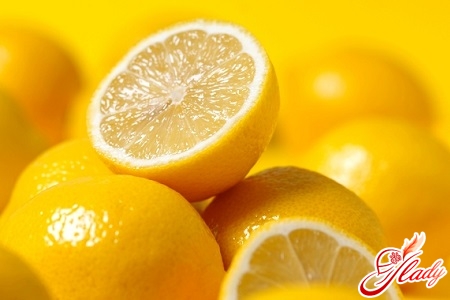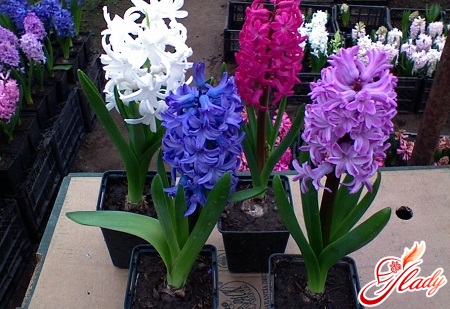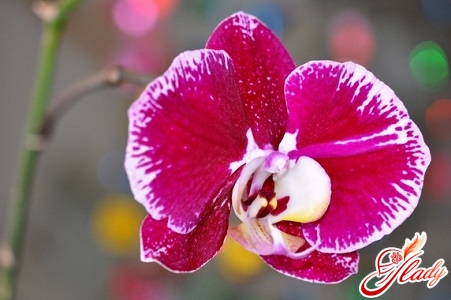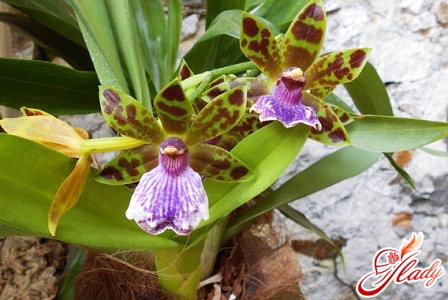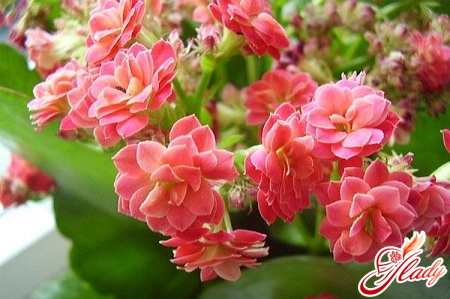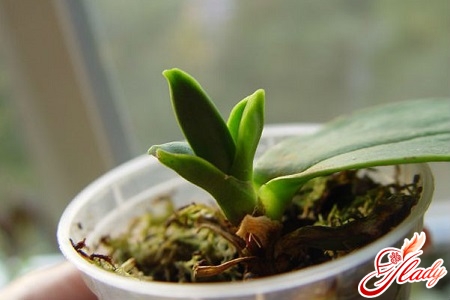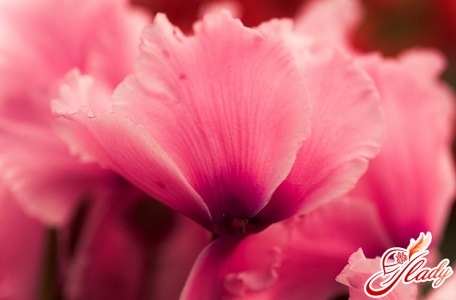 Cyclamen is a captivating indoor plantgardeners with their delicate sunny flowers. The petals of the flowers are rich in their color palette: white, pink, dark red, burgundy, purple and other possible options. And the whole value and beauty of this flower is that the flowering period falls on the most stingy time of the year - in winter. Yes, yes, exactly when basically all the plants have already dropped their flowers, and there is so little sun outside, cyclamen pleases and inspires us with its flowering appearance. This perennial plant got its name from the Greek word "cyclos", which means "circle". This is the shape of the main vital organ of the flower - the bulb. The most common among indoor species of cyclamen are "European", also known as "Alpine violet", and "Persian". Many lovers are afraid to start cyclamen, arguing their decision with the difficult maintenance and frequent diseases of the plant. Why? Caring for the flower is not particularly difficult if you know the basic rules for the favorable maintenance of cyclamen. And the flower gets sick no more often than other plants. But yes, unfortunately, mistakes in improper care have a detrimental effect on the condition of the flower: the leaves dry out, the roots rot, and as a result, cyclamens do not bloom.
Cyclamen is a captivating indoor plantgardeners with their delicate sunny flowers. The petals of the flowers are rich in their color palette: white, pink, dark red, burgundy, purple and other possible options. And the whole value and beauty of this flower is that the flowering period falls on the most stingy time of the year - in winter. Yes, yes, exactly when basically all the plants have already dropped their flowers, and there is so little sun outside, cyclamen pleases and inspires us with its flowering appearance. This perennial plant got its name from the Greek word "cyclos", which means "circle". This is the shape of the main vital organ of the flower - the bulb. The most common among indoor species of cyclamen are "European", also known as "Alpine violet", and "Persian". Many lovers are afraid to start cyclamen, arguing their decision with the difficult maintenance and frequent diseases of the plant. Why? Caring for the flower is not particularly difficult if you know the basic rules for the favorable maintenance of cyclamen. And the flower gets sick no more often than other plants. But yes, unfortunately, mistakes in improper care have a detrimental effect on the condition of the flower: the leaves dry out, the roots rot, and as a result, cyclamens do not bloom.
Rules of maintenance for a favorable flowering
Cyclamen is mainly sold in garden storesin the fall, when the buds have already formed and begun to bloom. Therefore, when choosing a flower, pay attention to a plant that is already ready to bloom or has enough unopened buds. Naturally, the selected flower should not have any external damage, the leaves should be juicy and low-lying. The main criterion for further successful flowering is planting the cyclamen tuber. In no case should it be completely immersed in the soil, at least 1/3 of the part should be visible on the surface. Cyclamens love diffused light and react painfully to direct sunlight. If you keep the plant on a windowsill, be sure to shade it from the bright sun. The best option for the necessary sunlight is south-west windows. For good health and regular flowering, cyclamen requires cool air temperatures. In summer, +18 ° C is best, but not more than 23-25. If possible, dig in the plant in the garden in the shade. In winter, at the height of flowering, the air temperature should not be higher than 15°C. It is the low temperature that affects the formation of buds and long flowering. During the growing season, regular but moderate watering is necessary. Water often, but not abundantly. Do not allow the soil to dry out or, conversely, become over-watered. Make sure that water does not stagnate on the tuber and leaves - this can lead to rotting of the flower. To do this, pour water into the edge of the pot. It is best to use settled, soft water at room temperature. Excess liquid must be drained from the saucer so that the roots do not accidentally rot. Cyclamen is also partial to humidity. Before flowering, you can occasionally spray the flower from a spray bottle, but carefully ensure that water does not accumulate on the leaves. It is optimal to spray not the leaves, but the air around the flower. To increase humidity, it is also recommended to place the pot on a special tray with expanded clay, pebbles or wet moss. Remember: the roots of the plant should not come into contact with water. Depending on the species, under favorable conditions, the flowering period lasts from October to March. In the spring, as all the flowers fall, watering the cyclamen is gradually reduced. And by summer, the plant needs to be watered very rarely. The so-called dormant period begins, during which the leaves turn yellow, dry and fall off. Bare tubers remain. At this time, it is advisable to lay the pots with tubers on their sides and place them in a cool, shaded place. Closer to autumn, the pot is placed straight and the soil is gradually moistened.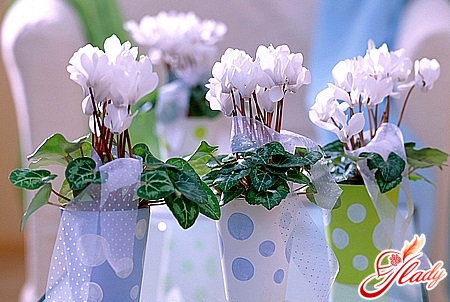
Cyclamen transplantation
In autumn a new flowering period begins,which is marked by the growth of small leaves. At this time, it is necessary to transplant the plant. The pot for transplanting should be small: for a small one-and-a-half-year-old tuber, a pot with a diameter of no more than 8 cm is selected; for 2-3-year-old bulbs, a 15 cm pot is suitable. Another option for choosing the right pot is as follows: the distance between the edge of the pot and the tuber itself should be from 3 to 4 cm. If cyclamen rots more often in a large pot, then premature and short-term flowering is possible in a small one. The result of an optimally selected pot will be lush flowering and a healthy root. The old soil is completely replaced. New soil mixture can be purchased at a garden store ready-made with the mark "for cyclamens". When preparing the soil yourself, use leaf soil, humus, river sand, turf or peat. Drainage and a ventilation hole at the bottom of the pot are required. It is recommended to heat or steam the prepared soil mixture, treat it with a weak solution of potassium permanganate, because cyclamen is very susceptible to pest attacks. The flower must be transplanted carefully, without damaging the root ball. Pay special attention: in order for your cyclamen to bloom, when transplanting the Persian variety, the bulb cannot be completely buried in the soil, be sure to leave 1/3 of the tuber on the surface. When transplanting other species, deep planting is allowed, but when transplanting the "Neapolitan" variety, it is imperative to completely immerse the tubers in the soil. Let us emphasize once again: incorrect planting of the bulb is a common mistake, and the main reason why cyclamens do not bloom. After transplanting, cyclamen is placed in a cool, bright place and watering is gradually increased. At the stage of intensive leaf growth before flowering, it is necessary to feed the flower with mineral fertilizers. It is best to use organic compounds. Avoid high nitrogen levels as this can lead to root rot.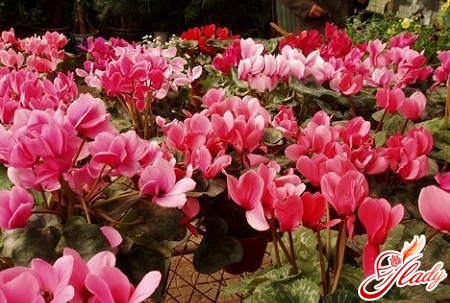
Diseases and pests that inhibit flowering
Often leads to rapid flower shedding and delaysSome cyclamen diseases occur during the flowering period itself. Let's look at the most common types. Fusarium is a fungal infection of plant tissues that secrete toxic substances into the leaf vessels. It manifests itself as yellowing of the leaves from the tops, mainly on one side of the plant. The entire flower, including the tuber, gradually becomes infected, which sooner or later leads to death. Wet rot is a bacterial and very dangerous disease. The initial stage is accompanied by sudden wilting and a rotten smell from the tuber. The root system is also susceptible to infection. There are no methods for combating rot; the plant must be destroyed. Gray rot is a fungal disease that manifests itself as the growth of gray mold on the leaves, causing the plant to turn yellow and die. Aphids are small, annoying insects of gray, green, or black color. They are dangerous because they suck the juice out of the plant's leaves. You can detect it by the curling of the leaves, the buds do not open, and the flowers are covered with sticky secretions. Further growth of the plant slows down. The situation is worsened by the defeat of sticky leaves by sooty fungus. The fungus, in turn, worsens gas exchange. The cyclamen mite is a very small insect, mostly yellow. At the initial stage, the mite settles on the inside of the leaf. The affected leaves curl, the buds wither and fall off. Thrips are an oval-shaped pest up to 2 mm in height. Using their wings, they fly from a sick plant to a healthy one. They leave a silvery trail behind, mainly affecting leaves, while the flowers become covered with spots and gradually wither. Pest control methods allow the use of chemical and biological preparations. But the best treatment, as always, is prevention, which consists of regular inspection of the cyclamen, periodic treatment of the leaves with special solutions and proper maintenance of the plant. On average, cyclamen lives 15-20 years, and in one period you can get up to 70 flowers. Gradually, withering buds should be removed along with the peduncle. Yellowing leaves should be plucked at the tuber itself. By the way, cut cyclamen flowers stand well in water. Split ends and regular changes of water in a vase extend the shelf life to 2-3 weeks. You will be interested to know about another feature of cyclamen tubers - they contain a poisonous substance that causes skin inflammation. While traditional medicine uses this flower to treat sinusitis, rheumatism, and homeopaths use cyclamen to treat female genital organs and diseases of the central nervous system. In ancient books, cyclamen is called pig bread, because these animals willingly feed on cyclamen roots. But for us, lovers and connoisseurs of indoor plants, cyclamen is close to flowers "fluttering" like butterflies. By following all the above recommendations, you will give yourself joy and a sunny mood during the long winter months, admiring the magnificent flowers.




